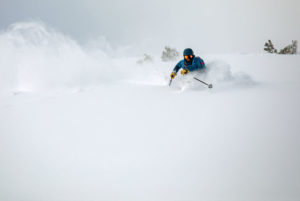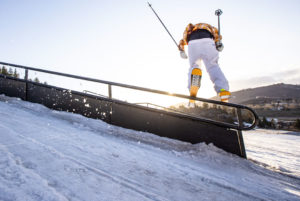
Traditional striding cross country skis will need regular waxing on the center third of the base to enable them to perform properly on the snow. Wax will keep dirt out of the base, prevent the base from drying out and will keep your skis gliding fast. Some cross country skis, however, are waxless. These are less common and grip the snow via an embossed base. Although not necessary, a thin layer of glide wax can be applied to a waxless base to help the skis move faster and to help keep snow from sticking to the base. For traditional waxed skis, the procedure is more involved. If you’re a beginner, you might need a little guidance on the waxing process. If any terms are unfamiliar, check out our glossary of the most common cross country ski terms. The following waxing instructions will not only aid in selecting and applying wax, but will also ensure that you get the most out of your skis this winter!
Choose a Wax
You’ll want to chose a wax that is best suited for the outside temperature. The most popular, hard waxes resemble a large crayon and perform best when temperatures are low and snow crystals are sharp. They are color coded for the appropriate temperature range. Klister waxes have a glue-like consistency and come in tubes. They are for warmer temperatures and snow that has been repeatedly melted and frozen. Lastly are spray waxes. These are a quick parking lot fix to be used only as a temporary wax.
The tips and tails of classic skis and the entire base of skate skis should be glide waxed. The kick zone (center third) of classic skis should be waxed with a grip wax.
Clean the Base
Before waxing, you’ll need to clean the base of the skis with a fine, steel brush to remove dirt and old wax. Always work tip to tail when waxing cross country skis. That will get the little micro hairs on the base laying down in the direction of travel on snow so you won’t be slowed down. Then use fine copper brush to clean it up a bit more.
When waxing the kick zone, mark it off with masking tape then scrape the area with a plastic scraper. Next, apply a small amount of base cleaner to the kick zone to remove more dirt and excess wax. Then, rub the area with a fine grade of sand paper wrapped cork.
Apply the Wax
To apply hard wax, rub a stick of hard wax on the kick zone of the base on each ski then buff with a cork. You can repeat two or three times, buffing after each coat. If you have an electric waxing iron, you can also apply binder wax as the first coat in the kick zone. Heat the iron to 110 degrees, then run it over the wax and let cool until it has reached room temperature again. Then, buff with a cork, and follow with wax. Buff the final coat with the cork, and, optionally, brush with a special nylon brush.
Once the kick wax has cooled, apply liquid glide wax to the nose and tail of the skis (the areas other than the kick zone.) Glide wax often comes in an applicator bottle with a sponge end, so you can apply it easily even in the parking lot of a ski area.
For klister wax, rub the kick zone with a sandpaper cork. Apply base klister in diagonal strips on either side of the groove. With a waxing iron set at 110°F, warm and smooth it onto the base, then let it cool and cork the area. Last, apply a universal or temperature-specific klister in the same pattern. Spread it out with a plastic scraper or a cork.
Use the wax temperatures listed on various waxes as a guideline. Let your own experience decide which wax works best for your conditions. In general, if the skis skid and slip rather than grab, the wax is too hard. If snow starts sticking to them, the wax is too soft.
Basic Waxing Principles
- Work from tip to tail for ironing, scraping and brushing in glide wax areas on the ski.
- Before waxing, make sure base is clean. This can be done via the brush method and/or with base cleaner.
- Triple check the iron temperature as too much heat can permanently damage the base.
- Never put an iron on a ski base that doesn’t have wax on it.
- When ironing, never stop the iron on the ski base.
- Wipe the iron before use to remove old wax or dirt.
Check out our Cross Country Accessories and Equipment for product details.
Be sure to browse our collection of cross country ski apparel and pants.








